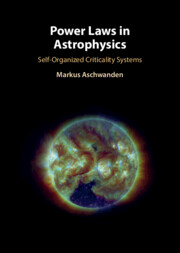Book contents
- Frontmatter
- Dedication
- Contents
- Foreword
- Preface
- Abbreviations
- Part I Fundamentals of SOC
- Part II Astrophysical SOC Phenomena
- 4 Solar Flare Hard X-Rays
- 5 Solar Flare Soft X-Rays
- 6 Solar EUV Nanoflares
- 7 Solar Photospheric Events
- 8 Solar Radio Bursts
- 9 Coronal Mass Ejections
- 10 Solar Energetic Particle Events
- 11 Solar Wind
- 12 Magnetospheric Phenomena
- 13 Planetary Systems
- 14 Stellar Systems
- 15 Galactic and Black-Hole Systems
- Part III Conclusions
- References
- Index
14 - Stellar Systems
from Part II - Astrophysical SOC Phenomena
Published online by Cambridge University Press: 05 December 2024
- Frontmatter
- Dedication
- Contents
- Foreword
- Preface
- Abbreviations
- Part I Fundamentals of SOC
- Part II Astrophysical SOC Phenomena
- 4 Solar Flare Hard X-Rays
- 5 Solar Flare Soft X-Rays
- 6 Solar EUV Nanoflares
- 7 Solar Photospheric Events
- 8 Solar Radio Bursts
- 9 Coronal Mass Ejections
- 10 Solar Energetic Particle Events
- 11 Solar Wind
- 12 Magnetospheric Phenomena
- 13 Planetary Systems
- 14 Stellar Systems
- 15 Galactic and Black-Hole Systems
- Part III Conclusions
- References
- Index
Summary
Among stellar systems, we find many with applications of SOC, such as stellar flares or pulsar glitches. Stellar flares occur mostly in the wavelength ranges of ultraviolet, soft X-rays and UV, and in visible light. A breakthrough in new stellar data was accomplished with the Kepler spacecraft, which allowed unprecedented detections of exoplanets, while the same light curves could be searched for large stellar flares. Exploiting these promising new datasets, one finds that most stellar flare datasets exhibit dominant size distributions that converges to a power law slope of , regardless of the star type. The size distributions of pulsar glitches are mostly found outside of the valid range of the Standard FD-SOC model and thus require a different model. Power law fits are not always superior to fits with the log-normal function or Weibull function. This discrepancy between observed and modeled power law slopes in stellar SOC systems is mostly due to small-number statistics of the samples, incomplete sampling near the lower threshold, and due to ill-defined power law fitting ranges, which can cause significant deviations from ideal power laws.
Keywords
- Type
- Chapter
- Information
- Power Laws in AstrophysicsSelf-Organized Criticality Systems, pp. 168 - 183Publisher: Cambridge University PressPrint publication year: 2024

